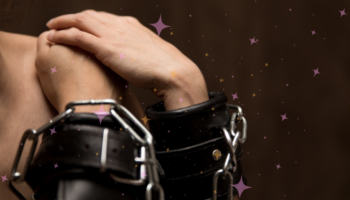When participating in bondage play with someone with disabilities, those disabilities can prove to be a challenge. After all, disabilities aren't just the things we an see. Partners may have health conditions like diabetes, asthma or depression, or suffer from panic attacks or epilepsy. That isn't to say that things will go wrong, but any potential risk to a partner must be considered. And, because safety is a core value in any kind of kink, disabilities can create anxiety and fear in the bedroom. The good news is that in many cases, kinky play with a disabled partner is just like kinky play with any other person: It requires communication, consent and care. Here are some tips on how to keep things safe, fun and sexy for partners of all abilities. (Want to learn more? Read 13 Myths About Sex and Disability.)
Ask your partner what you need to watch out for related to the disability. Is it a past injury? Panic attacks? What can you do if something goes awry? How can you prepare? This is especially important when it comes to invisible disabilities or conditions. Even if your partner just has asthma, you may still want to learn what you can do to help them in case of an asthma attack during a play session. You might want to take a first aid class, or learn basic anatomy to help you with your bondage skills and safety as well. Learn what you can and be receptive to listening and learning. A little education can go a long way in this regard! Communication goes hand-in-hand with education. In this case, be sure to communicate during the scene, too. Especially with bondage, care has to be taken not to pinch any nerves, or put undue strain on muscles. Make sure the rope or the cuffs aren't too tight; ideally, you should be able to slip two fingers in between. Speaking of rope, you may have to alter common ties to accommodate your partner. Putting too much pressure on one limb could cause problems. So, you would have to make sure to distribute the pressure of the tie in a different way. Communicate with your partner about how they would like check-ins to occur (Speaking? Touch? Any signals?) and work out safe words to warn you when a past injury, disability, or state of mind changes. Bondage can be intense for the mind, too, so make sure to communicate and check-in during the scene, whether you are tying or being tied. In case something DOES go wrong, have backup plans. Have safety scissors on hand to quickly cut free any rope and not break skin; have any medical equipment necessary depending on the particular needs of your partner. This may range from an emergency inhaler for asthmatics to medicine to a wheelchair. These should all be within easy reach in case you need to use or get back into them. You may also want to have a blanket or favorite item handy, not just for first aid and safety, but also to incorporate into aftercare for the sensory comfort
These tips all work together to ensure your play stays safe and sexy for everyone. So, make sure to take your partner's hand and go over these key issues, able bodies or not.





